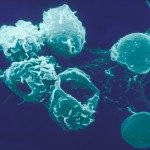Link to Pubmed [PMID] – 20142427
J. Exp. Med. 2010 Feb;207(2):273-80
The natural cytotoxicity receptor NKp46 (encoded by Ncr1) was recently shown to identify a subset of noncytotoxic, Rag-independent gut lymphocytes that express the transcription factor Rorc, produce interleukin (IL)-22, and provide innate immune protection at the intestinal mucosa. Intestinal CD3(-)NKp46(+) cells are phenotypically heterogeneous, comprising a minority subset that resembles classical mature splenic natural killer (NK) cells (NK1.1(+), Ly49(+)) but also a large CD127(+)NK1.1(-) subset of lymphoid tissue inducer (LTi)-like Rorc(+) cells that has been proposed to include NK cell precursors. We investigated the developmental relationships between these intestinal CD3(-)NKp46(+) subsets. Gut CD3(-)NKp46(+) cells were related to LTi and NK cells in requiring the transcriptional inhibitor Id2 for normal development. Overexpression of IL-15 in intestinal epithelial cells expanded NK1.1(+) cells within the gut but had no effect on absolute numbers of the CD127(+)NK1.1(-)Rorc(+) subset of CD3(-)NKp46(+) cells. In contrast, IL-7 deficiency strongly reduced the overall numbers of CD3(-)NKp46(+)NK1.1(-) cells that express Rorc and produce IL-22 but failed to restrict homeostasis of classical intestinal NK1.1(+) cells. Finally, in vivo fate-mapping experiments demonstrated that intestinal NK1.1(+)CD127(-) cells are not the progeny of Rorc-expressing progenitors, indicating that CD127(+)NK1.1(-)Rorc(+) cells are not canonical NK cell precursors. These studies highlight the independent cytokine regulation of functionally diverse intestinal NKp46(+) cell subsets.






